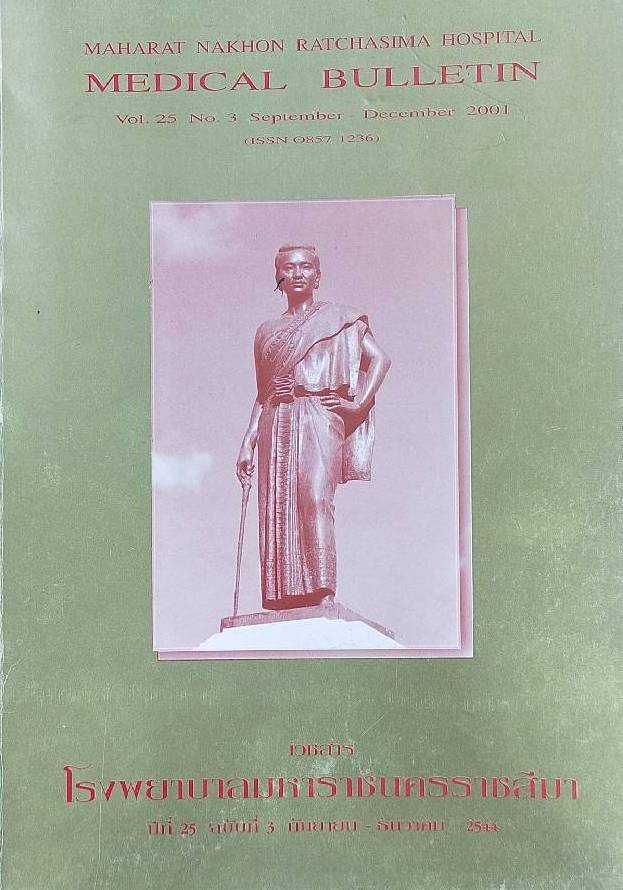ปัจจัยที่มีความสัมพันธ์กับการเกิดโรคข้อเข่าเสื่อม กรณีศึกษาผู้ป่วยในโรงพยาบาลมหาราชนครราชสีมา
Main Article Content
บทคัดย่อ
บทคัดย่อ: การศึกษาปัจจัยที่มีความสัมพันธ์กับการเกิดโรคข้อเข่าเสื่อม hospital-based case-control study ในโรงพยาบาลมหาราชนครราชสีมา ระหว่างเดือนสิงหาคม ถึง กันยายน พ.ศ.2542 กลุ่มศึกษาเป็นผู้ป่วยโรคข้อเข่าเสื่อมที่มีอายุ 45 ปีขึ้นไป 210 ราย และกลุ่มเปรียบเทียบเป็นผู้ป่วยด้วยโรคกระดูกอื่น ๆ ที่มารับบริการตรวจรักษาที่ห้องตรวจศัลยกรรมออร์โธปิดิกส์ ในช่วงเวลาเดียวกัน จำนวน 210 ราย รวบรวมข้อมูลปัจจัยต่าง ๆ ที่เกี่ยวข้องกับการเกิดโรคข้อเข่าเสื่อมโดยแบบสัมภาษณ์ซึ่งประกอบด้วย ลักษณะทางประชากรและสังคม ประวัติสุขภาพ พฤติกรรมสุขภาพทั่วไป วิเคราะห์ความสัมพันธ์ระหว่างปัจจัยกับการเกิดโรคข้อเข่าเสื่อมด้วย Multiple logistic regression เพื่อควบคุมอิทธิพลของอายุและเพศ พบว่า ดัชนีมวลกาย 25.0 ถึง 29.9 กิโลกรัม/เมตร2 และ 30.0 กิโลกรัม/เมตร2 ขึ้นไป เพิ่มความเสี่ยงต่อการเกิดโรค 2.27 เท่า (95% CI = 1.41 ถึง 3.63) และ 6.75 เท่า (95% CI = 2.71 ถึง 16.80) การนั่งคุกเข่า การนั่งยอง ๆ และการนั่งพับเพียบนานกว่า 6 ชั่วโมงต่อสัปดาห์ เพิ่มความเสี่ยงต่อการเกิดโรค 20.90 เท่า (95% CI = 10.70 ถึง 40.80) 16.62 เท่า (95% CI = 9.36 ถึง 29.48) และ 4.86 เท่า (95% CI = 2.77 ถึง 8.54) ตามลำดับ เพื่อลดโอกาสเกิดโรคข้อเข่าเสื่อม ควรหลีกเลี่ยงการนั่งคุกเข่า การนั่งยอง ๆ และการนั่งพับเพียบเป็นเวลานาน ๆ รวมทั้งควบคุมน้ำหนักเพื่อให้อยู่ในเกณฑ์มาตรฐาน
Article Details

อนุญาตภายใต้เงื่อนไข Creative Commons Attribution-NonCommercial-NoDerivatives 4.0 International License.
เอกสารอ้างอิง
Sharma L, Hurwitz DE, Thonar EJ-MA, et al. Knee adduction moment, serum hyaluronan level, and disease severity in medial tibiofemofal osteoarthritis. Arthritis Rheum 1998; 41:1233-40.
Spector TD, Hart DJ. How serious is knee osteoarthritis? Ann Rheum Dis 1992;51:1105-6.
Chaiamnuay P, Darmawan J, Muirden KD, Assawatanabodee P. Epidemiology of rheumatic disease in rural Thailand: a WHO-ILAR COPCORD study. J Rheumatol 1998;25: 1382-7.
ฐิตเวทย์ ตุมราศวิน. โรคข้อเสื่อม. ใน: สุรวุฒิ ปรีชานนท์, สุรศักดิ์ นิลกาวงศ์, บรรณาธิการ. ตำราโรคข้อ. กรุงเทพฯ : เรือนแก้ว ; 2538. หน้า 360-74.
Felson DT, Chaisson CE. Understanding the relationship between body weight and osteoarthritis. Baillieres's Clinical Rheumatology 1997;11:671-9.
Cooper C, McAlindon T, Snow S, et al. Mechanical and constitutional risk factors for symtomatic knee osteoarthritis. J Rheumatol 1994;21:307-13.
สุจิตรา ไชยพัฒนะพฤกษ์. ปัจจัยที่มีความสัมพันธ์กับ การเกิดโรคข้อเข่าเสื่อม [วิทยานิพนธ์ปริญญาวิทยาศาสตรมหาบัณฑิต สาขาวิชาชีวสถิติ]. กรุงเทพฯ: บัณฑิตวิทยาลัย, มหาวิทยาลัยมหิดล; 2532.
ชูเกียรติ วิวัฒน์วงศ์เกษม. การกำหนดขนาดตัวอย่างสำหรับงานวิจัย. วารสารวิจัยวิทยาศาสตร์การแพทย์ 2537;8:121-46.
Brandt KD. Osteoarthritis. In: Fauci AS, Braunwald E, Isselbacher KJ,et al,editors. Principles of internal medicine. 14th ed. New York: McGraw-Hill;1998. p.1935-41.
Hart DJ, Doyle DV, Spector TD. Incidence and risk factors for radiographic knce osteoarthritisin middle-aged women. Arthritis Rheum 1999; 42:17-24.
Martin K, Lethbridge-cejku M, Muller DC, et al. Metabolic correlates of obesity and radiographic features of knee osteoarthritis: data from the Baltimore longitudinal study of aging. J Rheumatol 1997;24:702-7.
Felson DT, Zhang Y, Hannan M, et al. Risk factors for incident radiographic knee osteoarthri tis in the elderly. Arthritis Rheum 1997;40:728-33.
Davis MA, Ettinger WH, Neuhaus IM, Mallon KP. Knee osteoarthritis and physical functioning: evidence from NHANES I epidemiologic follow up study. J Rheumatol 1991;18:591-8.
Zhang Y, McAlindon TE, Hannan MT, et al. Estrogen replacement therapy and worsening of radiographic knee osteoarthritis. Arthritis Rheum 1998;41:1867-73.
Manninen P, Riihimaki H, Heliovaara M, Makela P. Overweight, gender and knee osteoarthritis [abstract]. Int J Obes Relat Metab Disord 1996;20:595-7.
Schouten JS, Ouweland FA, Valkenburg HA. A 12-year follow up study in the general population on prognostic factors of cartilage loss in osteoarthritis of the knee. Ann Rheum Dis1992;9:932-7.
Vingard E, Alfredson L, Goldie I, Hogstedt C. Occupation and osteoarthritis of the hip and knee. Int J Epidemiol 1990; 20:1025-31.
Mactzel A, Makela M, Hawker G, Bombardier C. Osteoarthritis of the hip and knee and mechanical occupation exposure: a systematic overview of the evidence. J Rheumatol 1997;24:1599-607.
Cicuttini FM, Baker JR, Spector TD. The association of obesity with osteoarthritis of the hand and knee in women: a twin study. J Rheumatol 1996;23:1221-6.
Sandmark H, Hogstedt C, Lewold S, Vingard E. Osteoarthrosis of the knee in men and women in association with overweight, smoking, and hormone therapy. Ann Rheum Dis 1998:151-5.
Spector TD, Hart DJ, Doyle D. Incidence and progression of osteoarthritis in women with unilateral knee disease in the general population: the effect of obesity. Ann Rheum Dis 1994;53: 565-8.
Davis MA, Ettinger WH, Neuhaus IM. The rolc of metabolic factors and blood pressure in the association of obesity with osteoarthritis of the knee. J Rheumatol 1988;15:1827-32.
Cooper C, McAlindon T, Snow S, et al. Mechanical and constitutional risk factors for symtomatic knee osteoarthritis. J Rheumatol 1994;21:307-13.
Hochberg MC, Lethbridge CM, Scott WW Jr, Reichle R, Plato CC, Tobin JD. The association of body weight, body fatness and body fat distribution with ostecarthritis of the knee: data from the Baltimore longitudinal study of aging. J Rheumatol 1995;22:488-93.
Hart DJ, Doyle DV, Spector TD. Association between metabolic factors and knce ostcoarthritis in women?: The Chingford study. J Rheumatol 1995;22:1118-23.


